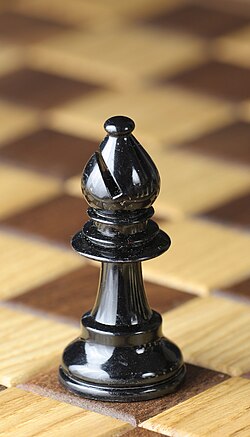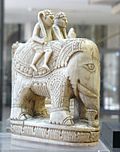Bishop (chess)
A bishop (♗) is a piece in the board game of chess. Each player starts the game with two bishops. At the start of a game, one bishop is placed in between the knight and the queen. This piece is the queen's bishop. The other bishop is placed between the knight and the king. This piece is the king's bishop. The bishops are also referred to as the light-square bishop and dark-square bishop, depending on the square color it starts on. In chess notation, the starting squares are c1 and f1 for White's bishops, and c8 and f8 for Black's bishops.
| Chess pieces | ||
|---|---|---|
| King | ||
| Queen | ||
| Rook | ||
| Bishop | ||
| Knight | ||
| Pawn | ||
History
The bishop first appeared in medieval European chess. In Chaturanga, the bishop was represented as an armed attendant who sat on the back of an elephant. The Arabs called this figure "al-fil", which means "elephant". However, elephants were not known in Central Europe, so they could not recognize the figure. The bishops were interpreted differently by the different nations. That is why the bishop is a "Läufer" (runner) in Germany, a "fou" (fool) in France and a "alfiere" (standard-bearer) in Italy.
How the bishop moves
The bishop moves diagonally. It can move as far as a player wants it to, unless another piece blocks its path. A bishop can never leave the color of square that it starts on.
In the centre of an empty board, a bishop can move to 13 squares.
Bishop (chess) Media
Elephant chess piece from the Charlemagne chessmen, 11th century
A pre-Staunton bishop
The bishops in the Lewis chessmen











